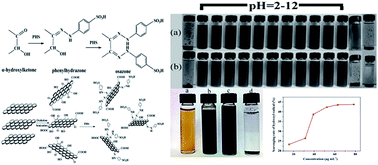Effects of phenylhydrazine-4-sulfonic acid on the reduction of GO and preparation of hydrophilic graphene with broad pH stability and antioxidant activity
Abstract
There are two kinds of functional group (hydrazine and sulfonic groups) in the molecule phenylhydrazine-4-sulfonic acid (PHS), so it was used in the reduction of graphene oxide (GO) to synthesize novel hydrophilic graphene (HG). The effects of PHS or PHS with caustic soda on the reduction of GO at 85 °C through a facile one-pot method were investigated. The results indicated that PHS was able to simultaneously serve as a reductant and modifier because of the presence of the two functional groups, and made HG not only able to homogeneously disperse in water, but also in polar organic solvents, such as DMF, DMSO, and 50% ethanol/water, even in the presence of polyvinyl alcohol, polyethylene glycol, cyanines and/or cyclodextrin. The solubility of HGa (HG by PHS) and HGb (HG by PHS with caustic soda) in water was up to 12.66 mg mL−1 and 9.27 mg mL−1, respectively. Meanwhile, HG was found to possess broad pH stability. It was able to readily form black homogeneous solutions without any precipitation in the pH range of 2–12. Besides, HG exhibited interesting antioxidant properties, and the scavenging rate of hydroxyl radicals of HGa could reach 42.5% with a concentration of 52.3 μg mL−1. The basic carbon skeleton of HG was graphene, but with a weakly crystallized structure, and it was transparent and non-aggregated with a hierarchical microstructure. In water, it possessed the maximum UV absorption wavelength in the range 250–290 nm.


 Please wait while we load your content...
Please wait while we load your content...